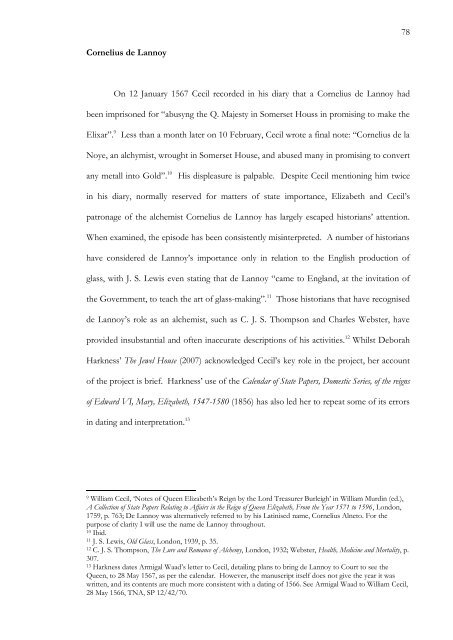The Alchemical Patronage of Sir William Cecil, Lord Burghley
The Alchemical Patronage of Sir William Cecil, Lord Burghley
The Alchemical Patronage of Sir William Cecil, Lord Burghley
You also want an ePaper? Increase the reach of your titles
YUMPU automatically turns print PDFs into web optimized ePapers that Google loves.
Cornelius de Lannoy<br />
On 12 January 1567 <strong>Cecil</strong> recorded in his diary that a Cornelius de Lannoy had<br />
been imprisoned for ―abusyng the Q. Majesty in Somerset Houss in promising to make the<br />
Elixar‖. 9 Less than a month later on 10 February, <strong>Cecil</strong> wrote a final note: ―Cornelius de la<br />
Noye, an alchymist, wrought in Somerset House, and abused many in promising to convert<br />
any metall into Gold‖. 10 His displeasure is palpable. Despite <strong>Cecil</strong> mentioning him twice<br />
in his diary, normally reserved for matters <strong>of</strong> state importance, Elizabeth and <strong>Cecil</strong>‘s<br />
patronage <strong>of</strong> the alchemist Cornelius de Lannoy has largely escaped historians‘ attention.<br />
When examined, the episode has been consistently misinterpreted. A number <strong>of</strong> historians<br />
have considered de Lannoy‘s importance only in relation to the English production <strong>of</strong><br />
glass, with J. S. Lewis even stating that de Lannoy ―came to England, at the invitation <strong>of</strong><br />
the Government, to teach the art <strong>of</strong> glass-making‖. 11 Those historians that have recognised<br />
de Lannoy‘s role as an alchemist, such as C. J. S. Thompson and Charles Webster, have<br />
provided insubstantial and <strong>of</strong>ten inaccurate descriptions <strong>of</strong> his activities. 12 Whilst Deborah<br />
Harkness‘ <strong>The</strong> Jewel House (2007) acknowledged <strong>Cecil</strong>‘s key role in the project, her account<br />
<strong>of</strong> the project is brief. Harkness‘ use <strong>of</strong> the Calendar <strong>of</strong> State Papers, Domestic Series, <strong>of</strong> the reigns<br />
<strong>of</strong> Edward VI, Mary, Elizabeth, 1547-1580 (1856) has also led her to repeat some <strong>of</strong> its errors<br />
in dating and interpretation. 13<br />
9 <strong>William</strong> <strong>Cecil</strong>, ‗Notes <strong>of</strong> Queen Elizabeth‘s Reign by the <strong>Lord</strong> Treasurer Burleigh‘ in <strong>William</strong> Murdin (ed.),<br />
A Collection <strong>of</strong> State Papers Relating to Affairs in the Reign <strong>of</strong> Queen Elizabeth, From the Year 1571 to 1596, London,<br />
1759, p. 763; De Lannoy was alternatively referred to by his Latinised name, Cornelius Alneto. For the<br />
purpose <strong>of</strong> clarity I will use the name de Lannoy throughout.<br />
10 Ibid.<br />
11 J. S. Lewis, Old Glass, London, 1939, p. 35.<br />
12 C. J. S. Thompson, <strong>The</strong> Lure and Romance <strong>of</strong> Alchemy, London, 1932; Webster, Health, Medicine and Mortality, p.<br />
307.<br />
13 Harkness dates Armigal Waad‘s letter to <strong>Cecil</strong>, detailing plans to bring de Lannoy to Court to see the<br />
Queen, to 28 May 1567, as per the calendar. However, the manuscript itself does not give the year it was<br />
written, and its contents are much more consistent with a dating <strong>of</strong> 1566. See Armigal Waad to <strong>William</strong> <strong>Cecil</strong>,<br />
28 May 1566, TNA, SP 12/42/70.<br />
78















